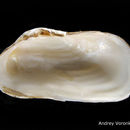fi
nimet breadcrumb-navigoinnissa


“Saxicava arctica, Linné, 1767. Plate 55, figs. 6, a.
Shell small, polymorphous, inequilateral, usually oblong, very rugose, thin, sometimes fragile, young specimens very often with posterior spinous ridges, white or light brown. Beaks approximate, slightly raised, tumid, tricarinate, 1 anterior and 2 posterior, incurved and acute. Anterior end much shorter, usually truncated or convex and very rapidly descending; posterior end frequently very long, truncated or convex; the basal margin broadly convex or more or less deeply sinuated. Epidermis thin, dull, brown. Sculpture consisting of very irregular, concentric, sharply raised, often anastomosing riblets, crowded in front, distant and rather lamellar posteriorly; 2 sharp ridges are descending on each valve from the umbones towards the posterior end, and in young specimens are usually ornamented with small tubular spines. Colour light brown or nearly white. Interior white, slightly shining, smooth. Hinge very narrow; right valve with an oblique small tooth below and just in front of the umbo, and a socket behind it; left valve with a small, conical, upturned tooth a little behind the beak. Ligament external, short, rather prominent. Adductor-scars unequal, the posterior larger. Pallial sinus shallow.
Dimensions extremely variable, the greatest length of shells I have seen being 17 mm.
Hab. – Throughout New Zealand, Chatham, Auckland, and Kermadec Islands.
The species is apparently distributed all over the globe, and is found from low-water mark to about 500 fathoms.
Fossil in the Pliocene.”
(Suter, 1913)
La Hiatella arctica és un mol·lusc bivalve marí pertanyent a la família Hiatellidae que habita en l'Oceà Àrtic, així com a Nova Zelanda, les illes Chatham i Macquerie (Austràlia). Viu en l'intermareal fins a una profunditat de 180 m per sota del nivell del mar.
Hiatella arctica, known as the wrinkled rock-borer, the arctic hiatella or the arctic saxicave, is a species of saltwater clam, a marine bivalve mollusc in the family Hiatellidae. The white shell of this mollusc is thick and more or less rectangular, but generally irregular in shape. It is up to 45 mm long.
Hiatella arctica is widespread and found in all the oceans, ranging from the Arctic and Antarctic to the subtropical and tropical zones. It occurs from the low water mark to depths of down to 800 m. It lives on hard substrates, often attached with byssus, for instance in mussel beds or nestling among kelp holdfasts, or hiding in rock crevices and also boring itself into soft rocks.
Hiatella arctica, known as the wrinkled rock-borer, the arctic hiatella or the arctic saxicave, is a species of saltwater clam, a marine bivalve mollusc in the family Hiatellidae. The white shell of this mollusc is thick and more or less rectangular, but generally irregular in shape. It is up to 45 mm long.
Hiatella arctica is widespread and found in all the oceans, ranging from the Arctic and Antarctic to the subtropical and tropical zones. It occurs from the low water mark to depths of down to 800 m. It lives on hard substrates, often attached with byssus, for instance in mussel beds or nestling among kelp holdfasts, or hiding in rock crevices and also boring itself into soft rocks.
Hiatella arctica es una especie de molusco bivalvo marino perteneciente a la familia Hiatellidae que habita en el océano Ártico,[1] así como en Nueva Zelanda, las islas Chatham y Macquerie (Australia). Vive en el intermareal hasta una profundidad de 180 m por debajo del nivel del mar.
La valva es gruesa y se sujeta a los agujeros o grietas de las rocas por fuertes hilos, aunque generalmente excava en rocas blandas. La valva es aproximadamente oblonga aunque muy irregular, tanto que dos especímenes no suelen ser iguales. Se observan claras líneas de crecimiento concéntricas e irregulares. Los umbos se hallan en el tercio anterior. Su coloración es blanca con un perióstraco marrón amarillento, e interior blanco. Pueden alcanzar hasta 40 mm de largo.
Esta especie se alimenta de forma suspensivora. Son cavadores de rocas blandas, siendo los adultos capaces de perforar la roca por abrasión mecánica.
Hiatella arctica es una especie de molusco bivalvo marino perteneciente a la familia Hiatellidae que habita en el océano Ártico, así como en Nueva Zelanda, las islas Chatham y Macquerie (Australia). Vive en el intermareal hasta una profundidad de 180 m por debajo del nivel del mar.
Hiatella arctica est marinum molluscorum bivalvium genus familae Hiatellidarum, in Oceano Arctico et circa omnes Novae Zelandiae insulas, Insulam Chathamensem, Insulamque Macquarie Australiae, ab aqua humili ad 180 m inventum.
Hiatella arctica est marinum molluscorum bivalvium genus familae Hiatellidarum, in Oceano Arctico et circa omnes Novae Zelandiae insulas, Insulam Chathamensem, Insulamque Macquarie Australiae, ab aqua humili ad 180 m inventum.
De noordse rotsboorder (Hiatella arctica) is een tweekleppigensoort uit de familie van de Hiatellidae.[1] De wetenschappelijke naam van de soort is voor het eerst geldig gepubliceerd in 1767 door Linnaeus.
Bronnen, noten en/of referentiesStenmussla[1], även stenborrmussla[2] (Hiatella arctica) är en cirka 4 cm lång mussla.
Den är vanlig som ledfossil i skalbankar men förekommer även allmänt vid svenska västkusten i håligheter på klippor och stenar på djup från ytan ner till 700 meter. Skalets form är avlång men ofta oregelbunden. [1]
Arten fördes tidigare till släktet Saxicava.
Stenmussla, även stenborrmussla (Hiatella arctica) är en cirka 4 cm lång mussla.
Den är vanlig som ledfossil i skalbankar men förekommer även allmänt vid svenska västkusten i håligheter på klippor och stenar på djup från ytan ner till 700 meter. Skalets form är avlång men ofta oregelbunden.
Arten fördes tidigare till släktet Saxicava.